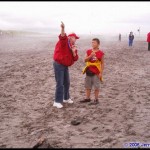We all pay our “lip service.” Everybody says it:
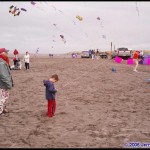 KITES are for KIDS of all ages !!!
KITES are for KIDS of all ages !!!
Yeah, we say that at Kitelife, too. Among other things, of course… And we’re generally talking about the “kid” in all of us too! But it’s not all that often that we’re actually talking about youngsters…
Anyway, every year for the entire third week in August, there’s this huge kite festival out in Washington State called the Washington State International Kite Festival – fondly known as WSIKF! And, like any other Kite Festival put on by grown-ups, kids used to sorta get lost in the mix, somehow…
No, it wasn’t intentional – far from it in fact. But kids didn’t do too well wandering around among the huge inflatables and cellulars and other “large” kites at WSIKF, plus the Bols and Crowns and Banners and Arches that inhabit the beach itself. And if truth be known, kids weren’t exactly welcome around the competition fields either. Those fields are reserved for the “grandstand” shows (the Rok Battles, handmade-kite judged competitions, kite demonstrations, and so forth). The participants don’t usually have “Kid-Friendly” as their paramount interest, especially when a kite flown by an inexperienced kid brings down the “real” kites–for the third time!
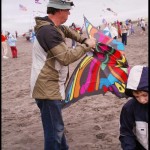 Kids do have a day set aside for them at WSIKF!
Kids do have a day set aside for them at WSIKF!
Well, there’s been a slight shift in WSIKF’s priorities over the last couple of years. So, if you’re a kid – or the parent or grandparent or guardian of a kid – then WEDNESDAY is YOUR day at WSIKF! Yes, a whole day, with plenty of hands-on and kite-play-in-the-sand events for kids to enjoy. And – YES – we DO mean “kids” of all ages…
WSIKF has long featured “Kids Events” in the morning and the “Kids Kitemaking” booth in the afternoon. These activities are popular and are continuing. However, the more recent “Kids’ for Today” events are the brain-child of Glenda Kleppin, Washington Kitefliers Association’s Special Events Coordinator. She is a long-time festival attendee, Kid’s Day organizer, and a champion of all Kids, including her own grandchildren whose complaint that there was “not much for kids” at a prior WSIKF inspired the new events.
And, before we go too much farther – I’ll happily reiterate that the term “kids” includes all those who have a “young” outlook and attitude, NOT just youngsters under a certain age. Glenda felt that kids weren’t getting their fair share of the beach during WSIKF, and she set out to change a few attitudes on that score, and came up with a really simple plan – one that actually works!
Here’s the concept…
Say you’re a kid – oh, say somewhere between 5 and 14 years old, and you just happened to show up at WSIKF. You want to “play kites” with the big kids (grown-ups), but you don’t own a kite and have no kite-flying experience! All you have is interest and enthusiasm…
Well, Glenda’s “Foster Grandparents” program will match you with an experienced kite-flier, who will mentor you through the whole process. The “Foster Grandparent” will actually help you assemble and fly a kite of your own. All the kids finish the day with some pretty fine gift-kites from their Grandparents.
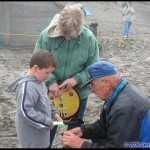 So what’s the program really all about?
So what’s the program really all about?
Well, first off – it’s about “quality-time” for all concerned. The kid gets an experienced teacher who brings a decent kite for the kid to fly, one that will help them learn the whats and whys and hows of kite-flying, including important information about flying safety. The Grandparent will stick with the Kid through the whole process. In exchange, the kids bring their open minds, interest in kite flying, and enthusiastic attitudes… Therefore, the Foster Grandparent gets a willing and enthusiastic “Grandchild” to teach, mentor, and enjoy… and maybe a new kite-flying friend in the process. Done right, the whole thing is a Win/Win situation for all concerned. And if that were all that really happened, we’d certainly consider the whole thing a success, right?
But it doesn’t stop there… It gets even better!
There’s actually a whole “package” of Kids/Grandparents events that help make the day memorable – and they make all the difference. They allow both kids and Grandparents to see Kid’s Day at WSIKF as truly a “Big Deal!”
First off, there are the actual fun Events that occur (and are judged and awarded)…
– Best Kids’ Camp: Join with your friends or work alone to set up a camp display that appeals specifically to kids.
– Foster Grandparent Fun Fly: This event is similar to a Mass Ascension with a few extra twists. All flying must be done in “grandparent/grandchild” pairs.
– Top Kid award: Flying a kite brings out the “inner child” in all of us.
Secondly, there’re Awards – which means judging! The whole day is overseen and supervised by knowledgeable people who’ve actually “done it before!”
– Of course there are the usual WSIKF prize “Ribbons” for these events… And, yes – both Children and “Grandparents” get ribbons, because these awards are only given to kid/adult “pairs.”
– For the “Grandparents” signing up – the first 100 adults will get WKA/WSIKF pins specially designed by Jack Judd and Glenda. (So if you’re a Pin Collector, here’s another one for you.)
– In addition, the top 10 grandparents will be awarded a limited edition pin.
– All the kids, of course, get a free kite.
– Ribbons and pins for the “Best Kids’ Camps” can be won by anyone, adult or child.
– Finally, there’s also a “Top Kid” Award as a grand finale to the entire day spent on the field!
In addition, All “Kids Day” Winners will also receive Special Recognition at the WKA Spaghetti Feed on Wednesday night.
And the most outstanding “Top Kid” will be recognized on a Display Plaque to be displayed in the World Kite Museum at Saturday night’s Museum Banquet.
Yes, the whole day is intentionally built to provide “Kids of all ages” the chance to come together for a day of kiting fun, sharing, friendship, mutual respect, and recognition!
And – since this is the fourth year for this format for WSIKF’s Kid’s Day, we really can say – this one WORKS!!!
All right… We’ve made our “pitch” for Kid’s Day at WSIKF this year now…
But… we happen to think there’s much more to the story, including some things you readers might want to consider for YOUR next kite festival…
Back to the Concepts:
We’re going to share some of Glenda Kleppin’s operating philosophies here. And – if you’re an event organizer or a festival “committee person” you’re welcome, and even encouraged, to use whatever you think might work for your festival from these ideas!
- I queried Glenda regarding why the old way didn’t work? After all, many festivals get by with a “Make-A-Kite” booth creating plastic Sleds or Eddys that the kid constructs from pre-cut patterns, tacks on a hank of cotton string, and then fly by themselves. (…like your festival?) Her response is:
“Too many kids just run around in circles for a few minutes with the kites they make at festivals, and then start running across the flying fields, cutting strings and/or tangling the “real” kites that are flying there. The kite ends up in the trash by the end of the day, and the kid has learned nothing about successful kite flying. That’s why I want the folks to bring flyable kites and to have to teach the kids on a more individual basis–like a real grandparent (or parent) would be expected to do.”
.
- Well, why call it a “Foster Grandparent Program?” Why not just a “helper” or “mentoring” program?“Why a “Foster Grandparent’s Fly”? When I first started attending WSIKF, the Wednesday events were targeted at kids and people over 50. For that reason, I decided that I wanted to combine the two age groups as I had done back in the years when I was training preschool teachers by using the “Foster Grandparent Program”, which is now a part of Senior Corps. According to their website: “Foster Grandparents serve as mentors, tutors, and caregivers for at-risk children and youth with special needs through a variety of community organizations, including schools, hospitals, drug treatment facilities, correctional institutions, and Head Start and day-care centers. In fiscal year 2001 more than 30,000 Foster Grandparents tended to the needs of 275,000 young children and teenagers.”
“The theory behind the program was that parents are often too busy with meeting the everyday needs of life for kids, while Grandparents more often have time to actually play with the kids (or join them in their own second childhood). That perfectly described what I envisioned for this event – adults and kids playing together as equals.”
“The members of the kite community have succeeded in recovering their wonder of the simple joy of making and flying kites. Now it is time to pass this wonder on to the youngsters who will eventually take our places. It’s all about attempting to draw kids into the excitement and creativity of the sport of flying kites.”
. - It looks like you’ve made some minor changes to the format every year. Why is that?“I was more interested in initiating a process rather than making rules for what people should do. The very special nature of these events is that people have taken my suggestions and used their personal creativity to make the event even better and more meaningful. For instance, every year Karen Highfield has used the Foster Grandparent event as an excuse to throw a big birthday bash for as many kids as she is old–and she started at 55. Who’d believe anybody was brave enough to make that many kites and assemble a large enough crew to teach them all how to fly them? She, and others, were the inspiration for what has become the “Top Kid” award.”
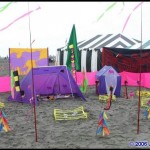 “Another example was the response to the “Kids’ Camp” category. Imagine my surprise to find that someone had taken me literally and helped their child create and set up their camp, complete with miniature tents, banners, and trees, all made from ripstop. Ryan King not only had her camp set up on Wednesday, but actually had it set up almost the entire week at last years’ WSIKF. It has been an awesome addition to the beach display.”
“Another example was the response to the “Kids’ Camp” category. Imagine my surprise to find that someone had taken me literally and helped their child create and set up their camp, complete with miniature tents, banners, and trees, all made from ripstop. Ryan King not only had her camp set up on Wednesday, but actually had it set up almost the entire week at last years’ WSIKF. It has been an awesome addition to the beach display.”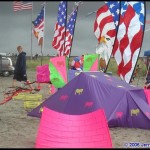 “That’s the whole reason I’ve included the bit about bribing the judges. I wanted people to do whatever they were inspired to do, and not feel limited by some silly set of rules of how things “have to be done.” After all, kids don’t always WANT to color inside the lines. I want these events to be fun, so I make changes to the categories as people add their own ideas/interpretations to the mix and that makes the events better each year. Of course, I also enjoy my yearly chocolate bribes…”
“That’s the whole reason I’ve included the bit about bribing the judges. I wanted people to do whatever they were inspired to do, and not feel limited by some silly set of rules of how things “have to be done.” After all, kids don’t always WANT to color inside the lines. I want these events to be fun, so I make changes to the categories as people add their own ideas/interpretations to the mix and that makes the events better each year. Of course, I also enjoy my yearly chocolate bribes…”
. - Well, how do you structure the day in order for it to be successful? What were you originally looking for?From one of Glenda’s solicitations:
“Please join Washington Kitefliers Association and other WSIKF participants in an effort to make the sport of kiting more accessible to our youngest spectators. Judging in all of the events will be based on showing kites, ground displays, and anything else that will particularly appeal to the “under 14″ crowd. Please include things like: kids’ songs; books; cartoons and comics; nursery rhymes; movies; and TV characters. Judges will have wide discretion in awarding points and can probably be bribed or otherwise influenced. (Chocolate is a good choice.)”
From Glenda’s “Events Guidelines”
“Best Kids’ Camp: Join with your friends or work alone to set up a camp display that appeals specifically to kids. Current or classical books, movies, songs, and/or nursery rhymes may provide inspiration for your display.”
“Kids like things they can touch and see up close and they love learning about the history of kites; how to make kites; and how to identify the different kinds of kites. You will earn extra points if you have educational displays and/or actual kite making activities taking place at your camp. Let’s get kids hooked on something good while they are young and impressionable!”
“Foster Grandparent Fun Fly: This event is similar to a Mass Ascension with a few extra twists. All flying must be done in “grandparent/grandchild” pairs.”
“Top Kid Award: On the beach, ribbons will be awarded to individuals who best exemplify the joys of childhood through their beach activities, crazy hats/costumes, and whatever else attracts positive attention on the beach. You can either sign up for this competition (in the appropriate age categories); sign up someone else; or simply come to the attention of the judges as they are wandering around the beach. (Judges will not be responsible for erroneous assignments to the wrong age group.) No stuffed shirts allowed (unless they are part of a clown outfit).”
The rules are as follows:
“All “adult” kiters must be accompanied by a child under the age of 14, and, all kids under 14 who want to fly must be sponsored by a “foster grandparent”. Adults can provide their own grandchild or temporarily adopt children from the sign-up list.”
“Each “adult” will provide a kite for their “foster grandchild” to fly and keep, either hand-crafted or commercial. There will be a few extra kites available for those who come unprepared or you can purchase something at the World Kite Museum tent on the beach.”
“The “adults” will teach their “grandchild” how to safely and successfully fly the gift kite. Most of the “adults” will be experienced kiters who can give the “grandchildren” actual one-on-one, hands-on tutoring. We anticipate that many of the children will probably be from “spectator” families; may have never flown a kite before; and may have no one in their family experienced and/or patient enough to provide proper kite selection and flying instructions.”
And finally, from two articles Glenda Kleppin wrote:
From an article soliciting participation dated June of 2005:
“I may sound like a broken record on this subject, but I still get chills when I picture that field at Long Beach last year, filled with children — all happily flying their new kites and being tutored by adults on how to fly successfully and safely. Just think of this as a mass ascension where all the fliers are under 16 and are supervised by a knowledgeable adult. I’d love to fill the field with at least twice as many children next year, but I need the help of everyone to make this happen.”
“If you can, I’d love to have you bring your kites (as many as you like) to the field to teach the kids. But, if you can’t be at the festival and/or on the field, I’m asking that you still send or bring a kite for this event-–to me at my house or at the kite festivals, or to the WKA headquarters on the beach at any of the kite festivals, including WSIKF, and I’ll find someone to take that kite onto the field and make sure that a child learns to fly it. Homemade kites are wonderful, but the only real requirements for the kites are that they be sturdy enough to take a bit of abuse and to last for a while and that they be easy to fly.”
“There are a lot of kids at the festival who have never flown a kite and whose parents have no idea of how to fly properly and so cannot teach them. But, just remember, this event can’t be a success without the willing participation of lots of adults – and that means YOU. This is an excellent way to help bring new, younger kite fliers into the sport. Who knows, we may even get their parents hooked!”
From an article soliciting participation, dated June of 2004:
“I am very excited about the new “Kids for Today” events at WSIKF on Wednesday. We tried this on an experimental basis last year, and it is now a permanent part of the program. An article explaining the reasoning behind the events is presently online at the WSIKF website.”
“I am especially excited about the Foster Grandparent Fly. Last year, Elaine Ginser made 6 kid kites and invited spectator children to fly them for her during our “Kid’s Kites” fly. The idea for the Foster Grandparent event grew out of the excited response of the children to her invitation.”
“I was talking to Larry Ziler (Ben Franklin) about this event, and he pointed out that many of the parents who bring their children to the festival cannot afford to buy “quality” kites for the kids–even if they actually knew what a “quality” kite for kids looks like. This is especially true if there are several children in the family. And, of course, it is highly likely that none of the adults in the family have ANY experience with teaching a child how to safely fly their kite.”
“Participating in this event will give members of the kite community a chance to have a major impact on these kids and perhaps encourage a new generation of kitefliers. Maybe we can inspire other groups of kiters to include “Foster Grandparent Flies” in their festivals.”
Well, Enough! You have the gist of all this by now!
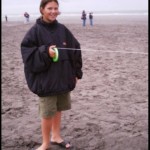 So… Plan to show up at WSIKF, bring your Grandkids, and participate!
So… Plan to show up at WSIKF, bring your Grandkids, and participate!
And if you can’t make it to Long Beach this August then you might see if you can’t influence the organizing committee of your own local Kite Festival to add/modify the “Kids” program they’re presenting – or the one they’re going to offer next time?
See you there,
Dave “Geezer” Shattuck
Author’s Note: While a large portion of the information for this article was gathered from the Internet, Glenda Kleppin provided substantial additional thoughts and details. Glenda is a retired attorney, a member of nearly every NW Kite Club in existence including the Washington Kitefliers Association, and a long-time display kiter and festival attendee. Thank you for your generous help, Glenda!
Should you wish to contact Glenda Kleppin, you can reach her by email here – specialevents@wka-kiteflyers.org






